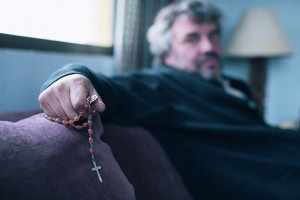 Review: Wisconsin Film Festival
Review: Wisconsin Film Festival
The Club | Pablo Larraín | Chile | 2015 | 98 minutes
Sundance Cinemas, Saturday, April 16, 6:30pm»
Sundance Cinemas, Monday, April 18, 3:45pm»
Erik Oliver looks at The Club, Chilean director Pablo Larraín’s portrait of former Catholic priests living comfortably despite representing deep institutional horrors of the church. The understated, low-key pace challenges us to loathe these people, and the film builds deliberately to some brutal sequences that remain enigmatic.
For much of its runtime, The Club remains fairly elusive. Chilean director Pablo Larraín (No, Post Mortem) places us into its sedate setting, and leaves us to decipher exactly what its characters are feeling, or what their purposes may be. Is it a parable? A social realist document? A political satire? Whatever it is, it builds deliberately to some sequences of real power.
The Club opens with a series of images that slowly clue us into its setting: a man running his dog in circles on the beach, a group of men praying at dinner, then watching a dog race in town with binoculars. This lackadaisical beginning lulls us into a sense of routine that the film soon overturns with a shocking act of violence.
These men are ex-priests, unable to continue their jobs for varying, obscured reasons—many implicitly involving sexual abuses. They have been placed into this retirement home of sorts by the Catholic Church. Watched over by Sister Mónica (Antonia Zegers), they’re there to repent, but their schedule is decidedly relaxed. The film’s muted, washed-out colors and low-key pace lull us into a disturbing sense of security that challenges us to pay enough attention to loathe these people.
Their main form of recreation is training their dog, Rayo, for racing, where they also get their limited income. They don’t seem repentant; they seem bored. Then a priest joining the home publicly kills himself after he is loudly confronted by one of his old altar boys and victims, Sandokan (Roberto Farías).
The Church sends in a new priest, Padre Garcia (Marcelo Alonso), to investigate, and the situation immediately becomes tense. Sister Monica says Garcia is one of the “new priests” looking to reform the Church and end the kind of homes in which these priests reside. He looks to upset their routine. When he asks them about the incident, they lie.
 Larraín isn’t interested in telling the personal stories of these people, who are damaged and have damaged others, or offering a redemption story. Nor does The Club seem to vilify them in the way we’d expect. The film stays at a distance, and doesn’t side with any of its characters. The priests serve as protagonists, but not sympathetic ones due their apathy and complacency. They are representatives of deep institutional horrors, and they get to live a quiet seaside life, where little ever happens.
Larraín isn’t interested in telling the personal stories of these people, who are damaged and have damaged others, or offering a redemption story. Nor does The Club seem to vilify them in the way we’d expect. The film stays at a distance, and doesn’t side with any of its characters. The priests serve as protagonists, but not sympathetic ones due their apathy and complacency. They are representatives of deep institutional horrors, and they get to live a quiet seaside life, where little ever happens.
The film follows the parallel stories of Garcia’s investigation and Sandokan’s past. While neither story escalates dramatically, they do eventually culminate in sequences of brutality that throw the film’s main ideas into dramatic light. Even when it goes for shocks, though, The Club never quite articulates what, exactly, it’s trying to say. By the time the movie reaches its climax, it continues to challenge and undermine our assumptions more than it tries make a statement.
Nearly no one in The Club is a typical identification figure, making it an inherently political film with characters who are all enigmas. The priests are mild at most, only revealing their inner thoughts through interviews (interrogations?) with Garcia. Despite appearing as a valiant figure who aims to reduce the corruption in the Church, Garcia goes to questionable lengths to protect his institution. Sister Monica is an ambivalent-to-brutal figure with unclear motives as jailor and protector to the priests.
The only character not of the cloth in some way is Sandokan, whose story revolves around his past trauma and its effects on his life. Yet The Club dips into muddled psychology and ambiguity here, too, never giving Sandokan any kind of catharsis or moment of clarity.
It’s hard to take The Club to task for its lack of clarity; more than anything, it seems to want to probe us, to make us consider its characters. Understatement weakens its dramatic impact, but makes the film politically tough to shake. Ultimately, it doesn’t have easy answers or clear condemnations to make; it just wants us to see the club, and who lives in it and outside it, and make our own conclusions.